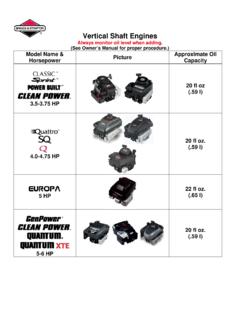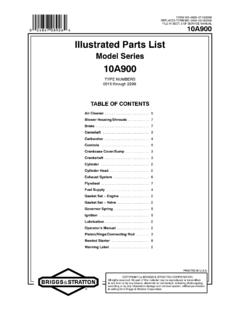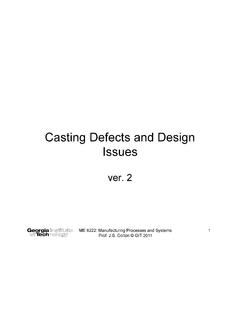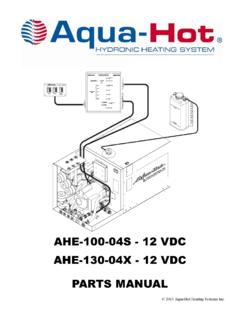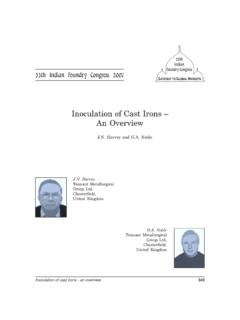Transcription of Carburetion Troubleshooting Detail Reference Guide
1 Carburetion TroubleshootingQuick Reference GuideFailure Table #1 Fuel Supply No Fuel in Tank Fuel Shut-Off Valve Kinked Fuel Line Fuel Filter, Restricted Fuel Level Low Fuel Tank Mounting Low Fuel Pump Fuel Solenoid Vapor LockFailure Table #9 Won't Stay Running, Carburetor Bowl Gasket Bowl Nut Bowl Vent Air Cleaner Manifold Porous Casting Warped Tank Gaskets Loose ScrewsFailure Table #2 Under Choke Choke Cable Choke Control Cable Choke Linkage Choke Shaft Inoperative Choke Plate Manifold Gasket No Human InterventionFailure Table #10 External Fuel Leaks, Fuel System Hole in Tank Loose Fitting Loose Fuel Line Clamp Human Intervention Fuel Line Fuel Filter, Leaks Sediment Bowl Gasket Fuel Shut-Off ValveFailure Table #3 Primer Primer Bulb Check Valve Primer Line Backing Plate Gasket Restricted, Passage No Human Intervention Manifold GasketFailure Table #11 Hesitation Float Adjustment Debris in Carburetor Jet, Main Fuel Mixture Screws Jet, Pilot Idle Speed, Mis-Adjusted Parasitic Load Fuel Quality Air Cleaner, Restricted Failure Table #4 Over Choke Choke Cable Choke Control Cable Choke Linkage Choke Shaft No Human Intervention Air Cleaner, Restricted Air Intake, Restricted Bi-Metal Choke Spring Automatic ChokeFailure Table #12 Hunting & Surging Jet, Main Fuel Restricted, Passage Jet.
2 Pilot GovernorFailure Table #5 Fuel Supply Head Pressure Pump Pressure Inlet Needle & Seat Float Porous Casting Fuel QualityFailure Table #13 Dies at Idle Restricted, Passage Jet, Pilot Welsh Plug Mixture Screws Idle Speed, Mis-AdjustedFailure Table #6 Primer Human InterventionFailure Table #14 RPM Issues, Runs Slow Throttle Control Throttle Control Cable Throttle Shaft Idle Speed, Mis-Adjusted GovernorFailure Table #7 Fuel Quality Stale/Old Fuel Wrong Type Fuel Contaminated Seasonal Fuel IssuesFailure Table #15 RPM Issues, Overspeed Throttle Control Throttle Control Cable Throttle Shaft Idle Speed, Mis-Adjusted GovernorFailure Table #8 Won t Stay Running Float Level Fuel Filter, Restricted Fuel Delivery Volume, Low Kinked Fuel Line Debris in Carburetor Failure Table #16 Can t Handle Load Float Adjustment Debris in Carburetor Jet, Main Fuel Mixture Screws Parasitic Load Fuel Quality Air Cleaner, Restricted Fuel Filter, Restricted Kinked Fuel Line Fuel Delivery Volume, LowSERVICE DIAGNOSTICOVERVIEWA logical, planned approachcan move service work througha repair center in a smooth andefficient manner.
3 Fueled byinformation from a thoroughQuick Check, the nature of therepair work required can bequickly the problem is estab-lished as an engine issue, theprocess continues through asystem of checks or tests untilthe affected engine system isdetermined. A skilled technicianwill accurately establish thesymptoms of the problem anddrill down to the root causesuch as those listed in thetables below. CE8123-11/03 Carburetion Troubleshooting Detail Reference Guide A Air Cleaner Manifold Problems involving the air cleaner manifold are normally related to loose mounting screws and/or damaged or leaking gaskets. A leaking gasket allows unmetered air to enter the intake system. Symptoms, based on severity of the leak, can range from an overly lean condition where the engine will have trouble accepting or handling load to the engine won t start or run at all.
4 See Backing Plate Gasket Air Cleaner, Restricted Restricted air filter elements effect engine operation differently based on the carburetor venting system. The mixture for Internally vented carburetors typically becomes lean while the fuel mix for externally vented carburetors becomes overly rich. Based on the carburetor design, effects can range from an engine that loads up and runs overly rich to an engine that can t handle a load because there is not enough fuel available. Air Intake, Restricted See A/C, restricted Automatic Choke The automatic choke function of the Pulsa-Jet carburetor used on vertical crankshaft lawnmower style engines can cause an overly rich condition during starting and operation. The default choke position is on.
5 If the diaphragm stiffens over time, it will not allow the choke plate to open smoothly and the choke can stay on longer than it should. If the diaphragm has a hole at the link or through the material, the choke will not disengage as it should. A small vacuum metering jet into the diaphragm spring cavity can become plugged, defeating the choke pull off. 1B Backing Plate Gasket A leak in an air cleaner backing gasket means, among other things, that unmetered air is entering the engine and leaning out the fuel mixture. This can result in power and performance issues. Some primer equipped carburetors use the air cleaner backing plate gasket to seal a passage through which air pressurized by the primer bulb travels. If this pressurized air escapes, the priming pulse is lost and the engine may be hard to start or will not start.
6 See Air Cleaner Manifold. Bi-Metal Choke Spring Used on vertical crankshaft lawnmower type engines with Pulsa-Jet and Vacu-jet carburetors, the Bi-metal spring aids the choke in staying closed to augment cold starts and assists the choke in opening when the engine is warm. Bowl Gasket Seals the carburetor bowl to the carburetor body. An improperly seated or damaged bowl gasket can result in fuel leaks. Bowl Nut On one-piece Flow-Jet carburetors, the bowl nut secures the float bowl to the carburetor body and seals against leakage via the bowl nut gasket. Should damage to the gasket occur, external fuel leakage is probable. Bowl Vent Air at normal ambient pressure is allowed access to the float bowl via the bowl vent. The vent assures smooth fuel delivery.
7 As fuel is removed from the bowl by the carburetor circuits, volume is being removed. Unless air can enter to take up the space, the pressure in the bowl will drop, effecting fuel delivery through the circuits. An engine with an obstructed bowl vent will act as though it is running out of gas. Engine symptoms can be hard starting, hesitation, and hunting and surging. CC Check Valve Pulsa-prime carburetors. This wet bulb primer incorporates a check valve in the priming circuit that allows fuel to fill the bulb via the fuel supply but closes when the bulb is depressed. If the valve leaks or does not work, there will be reduced or no prime and a hard or no start condition. Choke Control See Choke Linkage, Choke Control Cable Choke Control Cable Both the throw of the choke control cable and the location of the cable clamp will effect the 2operation of the choke mechanism.
8 If the choke will not fully close, cold starting can be difficult. If it does not fully disengage, engine operation can be effected. Choke Linkage Choke linkage that is misadjusted or damaged can cause improper engagement or disengagement of the choke mechanism. If the choke will not fully close, cold starting can be difficult. If it does not fully disengage, engine operation can be effected. Choke Shaft One of the few moving parts in the carburetor, the choke shaft determines the range of motion of the choke plate. Should the shaft become restricted in its travel, the choke plate will correspondingly be limited in motion. Without full choke engagement, an engine may be hard to start or not start at all. Contaminated A carburetor should contain nothing but fuel and air.
9 The presence of anything else suggests that the carburetor is contaminated. In terms of fuel contamination, this can be anything in the fuel that does not belong there such as dirt, debris, varnish, water, etc. DD Debris in Carburetor Debris, also grouped with dirt, can be considered as any loose material found in fuel systems that is not fuel. Some dirt and/or debris will cause no problems because it is small enough to pass through all the orifices. Of concern is material that blocks or limits fuel or airflow. Effects will vary based on the degree of blockage. Minor blockage of a fuel passageway may result in a slight hesitation. Complete blockage can result in a no start condition. Debris in air passageways may result in hesitation or overly rich running conditions.
10 F Float Found in Flow-Jet carburetors, the float controls the operation of the inlet needle and seat. As the name implies, the float floats on top of the fuel in the carburetor bowl. Based on the float level adjustment, The float position will either shut off the fuel supply via the inlet needle and seat or pull the Float Adjustment See float level. Most floats are non adjustable. If adjustment is possible, it typically involves bending a tang on the float bracket that will alter the float position. Float Level See Float. The float level establishes a base line for carburetor calibration/adjustment. The low pressure signal in the carburetor venturi is the force that accomplishes the work of 3moving fuel from the bowl to the carburetor throat.







